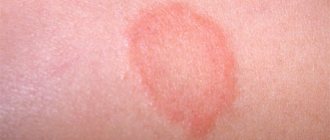IN THIS ARTICLE:
- Types of thermometers for children
- Which thermometer is better for a child, safer?
- Choosing a thermometer for a child by age
- How to measure temperature correctly?
- When should you see a doctor?
If your baby is feeling hot or you think he looks unwell, it may be time to take his temperature. Sounds simple enough, but if you're new to this, you may have questions:
- Which type of thermometer is best?
- Are thermometers different for infants and older children?
In our article you will find answers to all these questions and learn about everything you need to measure your child’s temperature.
Types of thermometers for children
The glass mercury thermometer was once the primary instrument for measuring temperature and was found in most home medicine cabinets. However, their use is not currently recommended because they can break and allow mercury to release harmful fumes into the air.
When choosing a thermometer for your baby, consider the following options:
- Digital thermometers.
These thermometers use electronic heat sensors to take body temperature readings. They can be used in the rectum (rectal), mouth (oral), or armpit (axillary). Armpit temperature is generally the least accurate of the three. - Ear thermometers
. These thermometers use an infrared scanner to measure the temperature inside the ear canal (eardrum area). Please be aware that earwax or a small crooked ear canal may affect the accuracy of the readings. - Temporal artery thermometers.
These thermometers use an infrared scanner to measure the temperature of the temporal artery in the forehead. They can be used even when the baby is sleeping.
Digital nipple thermometers
and
thermal strips
are not recommended.
Types of thermometers (thermometers)
Mercury thermometer
The most conservative and accurate way to measure a baby's temperature is with a mercury thermometer. Its main advantage is accuracy,
The measurement error is 0.1 degrees. Although, there are several disadvantages:
- Firstly, the measurement time (7 minutes in the armpit and 5 minutes in the rectum) is too long for a restless toddler;
- Secondly, this thermometer is not safe, as it contains mercury and is fragile, that is, it requires very careful handling, which is annoying when measuring the temperature of a baby.
Electronic
A more modern and convenient means for measuring temperature. Allows you to safely measure temperature
infants in any way: in the mouth, armpit and rectally, but in the armpit it gives less accurate indicators. Very easy to use:
- Measurement duration is approximately 3 minutes;
- Giving a signal at the end of the measurement; thermometer pacifier
- It comes in the form of a pacifier. Measurement time is up to 4 minutes. Suitable only for children who take a pacifier, so it will last you only as long as the baby uses a pacifier. Let's read in detail: what is a pacifier thermometer and is it worth buying for newborns?
An electronic thermometer has a larger measurement error than a mercury thermometer - up to 1 degree. In addition, the battery needs to be changed periodically.
Infrared
A recent invention, there is contactless and ear-based. The first instantly measures the temperature when it is brought to the skin. It is not highly accurate, but is convenient for monitoring temperature over time or for determining the temperature of milk formula.
An ear thermometer is very convenient to measure a baby’s temperature: in 5 seconds, while the baby is sleeping. These thermometers have one drawback - their high price.
Infrared Non-Contact Thermometer Infrared Ear Thermometer
Disposable
It comes in the form of strips that need to be applied to the skin or placed under the tongue. Measurement time – 60 seconds. It does not have high accuracy, but it can be convenient on the road.
Disposable thermometer
Which thermometer is better for a child, safer?
Basic precautions when choosing and using a thermometer for a child:
- Carefully read the instructions included with the thermometer before using it for the first time.
- Before and after each use, clean the thermometer tip according to the instructions.
- If you plan to use a digital thermometer to take your rectal temperature, purchase another one for oral use. Label each thermometer and do not use the same one in both places.
- For your safety and to ensure that the thermometer remains in place, never leave your child unattended while you are taking their temperature.
The best electronic thermometers for children
Xiaomi Miaomiaoce Smart Thermometer
- Availability of a phone application
- Country: China
- Price: 2000 RUR
- Rating (2020): 4.6
Smart thermometers have been gaining popularity lately, and this device is one of them. This device is a “disk” about 3 cm in size, which is attached to the child’s body and constantly measures his temperature (every 2.5 seconds). The received data is automatically sent to the application and displayed on the screen in the form of a graph.
- Advantages
- You can set a temperature limit upon reaching which a notification will be sent
- Easy calibration
- Several configuration options
- Compact
- Continuous temperature measurement
B.Well WT-04 Standart
- Anti-slip inserts on the body
- Country: UK
- Price: 370 RUR
- Rating (2020): 4.6
Another standard thermometer model, which has everything for comfortable measurement of body temperature: an automatic shutdown function to save battery power, a flexible tip to prevent injury to the child, sound indication and memory of the last value.
- Advantages
- There is a battery charge indicator
- Short measurement time (up to 1 minute)
- Bright design will attract the child's attention
- Can measure temperature rectally
Omron i-Temp mini
- Possibility to select units of measurement (°C or °F)
- Country: Japan
- Price: 400 RUR
- Rating (2020): 4.7
A standard model of an electronic thermometer with a minimum set of necessary functions: auto-shutdown after 30 minutes, sound signal upon completion, function of storing the last result. However, the thermometer is rightfully considered one of the best.
- Advantages
- Special tip for measuring in the armpit
- Manufacturer's warranty - 3 years
- Minimum measurement error
- Relatively inexpensive
- Suitable for controlling water temperature
Xiaomi Measuring Electronic Thermometer
- Convenient for visually impaired people
- Country: China
- Price: 700 RUR
- Rating (2020): 4.8
An electronic thermometer from a well-known Chinese company, which is famous for its multifunctional gadgets at an affordable price. The device is made of hypoallergenic materials - silicone and high-quality plastic. Allows you to measure temperature in the armpit and oral cavity.
- Advantages
- Waterproof plastic
- Easy to disinfect
- Auto shutdown time - 5 minutes
- Last value memory
Little Doctor LD-302
- Waterproof plastic
- Country: Singapore
- Price: 350 RUR
- Rating (2020): 4.8
Despite the fact that the functions of this thermometer are similar to others presented in the selection, it deserves a place in our top, as it is one of the most frequently purchased devices.
- Advantages
- Flexible body
- Flexible tip
- Long battery life (2 years or more)
- LCD screen
AND DT-501
- The most accurate
- Country: Japan
- Price: 289 RUR
- Rating (2020): 4.9
One of the most budget models, which, despite the price, has all the necessary functions: it allows you to measure temperature in the armpit, in the oral cavity or rectally. The measurement time is about 60 seconds, and the device will notify you of the end with a sound signal. In addition, this thermometer has a built-in function for storing the last result - very convenient for observing temperature changes over time.
- Advantages
- Universal
- Possibility of changing the battery
- Accuracy 0
- 1°C
- Storage case included
- Wide range of measured temperatures
- Minimum service life - 6 years
Choosing a thermometer for a child by age
The best option for a thermometer and the best place to use it, in some cases depends on the age of the child.
From birth to 3 months.
Use a regular digital thermometer to take your rectal temperature. You can also use a temporal artery thermometer—a new medical study has found that it provides an equally accurate reading of body temperature in newborns.
From 3 months to 4 years.
To measure a child's temperature at this age, you can use a digital thermometer (rectal, axillary). Also, a temporal artery thermometer will do an excellent job with this task. However, wait until your baby is 6 months old before you start using an ear thermometer.
If you are using a different type of thermometer and have doubts about the results obtained, additionally measure the child's rectal temperature.
From 4 years and older.
By age 4, most children can hold a digital thermometer under their tongue for a short time, long enough to get a reading. You can also use this thermometer to measure your armpit temperature. An ear or temporal artery thermometer is also great at this age.
The best non-contact infrared thermometers for children
B.Well WF-4000
- Widest measurement range
- Country: UK
- Price: 6000 RUR
- Rating (2020): 4.6
Another good non-contact thermometer, the distinctive feature of which is a special night display backlight for measuring temperature in the dark. Otherwise, it is a device with a standard set of functions, typical of other non-contact thermometers: high measurement speed (1 second), a sound signal to notify about the end of the procedure, an automatic shutdown function.
- Advantages
- You can turn off the sound signal
- Universal (for surfaces; body; liquids)
- Used in medical institutions
- Automatic calibration
- Batteries and case included
CEM DT-8806S
- Multifunctional
- Country: China
- Price: 4200 RUR
- Rating (2020): 4.8
Non-contact thermometer for remote measurement of body temperature. The operating principle is based on the absorption of energy from an infrared “laser” and its subsequent conversion into a numerical value. The device is ideal for home use - it can be used to find out not only body temperature, but also the temperature of surfaces and liquids (milk, baby food, bath water). In the video the model is slightly different.
- Advantages
- Memory for 32 values
- Backlit display
- Battery indicator
- Automatic shutdown after 7 seconds
- Small error (0
- 3°C)
- Measurement speed - 1 second
Sensitec NF-3101
- No calibration required
- Country: Netherlands
- Price: 7500 RUR
- Rating (2020): 4.9
One of the most accurate infrared thermometers with a stated error of 0.2°C and a minimum set of functions: memory for the last 30 values, measurement time - 1 second, sound signal, display backlight - everything you need for comfortable measurement.
- Advantages
- Lots of good reviews
- Fits comfortably in the hand
- Storage case included
- You can measure the temperature in the temporal region
How to measure temperature correctly?
Since there are several ways to measure the temperature of a small child, below we will describe how to use each of them correctly.
Rectal temperature
- Turn on your digital thermometer and coat the tip with Vaseline.
- Place the baby on:
- back and lift his hips;
- tummy and place your hand on your lower back to hold it in place;
- on your knees;
- any other hard surface.
- Insert the lubricated thermometer 1.3–2.5 cm into the rectum.
- Never try to push a rectal thermometer, especially if you feel any resistance. Hold the thermometer motionless until it signals that the measurement has been taken.
- Take out the thermometer and look at the readings.
Oral temperature
- Turn on your digital thermometer.
- Place the tip of the thermometer under the child's tongue towards the back of the larynx and ask him to close his lips.
- Take out the thermometer when it signals that the measurement has been taken and look at the readings.
If your child has eaten or drunk, wait 15 minutes before taking his or her oral temperature.
Armpit temperature
- Turn on the digital thermometer.
- Place it under your child's armpit and make sure it touches the skin and not the clothing.
- While the device is measuring the temperature, hug your baby and hold him to your chest.
- Hold the thermometer motionless until it signals that the measurement has been taken.
- Take it out and look at the indicators.
Ear temperature
- Turn on the thermometer.
- Gently place it in your child's ear. Follow the instructions that came with the thermometer to make sure you insert it the correct distance into your ear canal.
- Hold the thermometer motionless until it signals that the measurement has been taken.
- Take it out and look at the indicators.
Temporal artery temperature
- Turn on the thermometer.
- Gently bring it to the child's forehead.
- After the signal, look at the indicators.
When telling the doctor about your child's temperature, tell them how to obtain the readings.
Which children's thermometer is better to buy?
Our review of the best children's thermometers presents high-quality products. They are reliable and durable, sold at the best price and perform the task perfectly. The choice between them will not be difficult if you immediately decide on the type of thermometer and learn about its features. Thus, electronic models quickly show the result, notify about the completion of the procedure with a sound signal and are completely safe for the baby. Infrared products are good for their high accuracy and speed of temperature measurement, but they are often frightening due to their cost. And thermoment nipples are truly innovative inventions without mercury and glass, which are ideal for newborns, but they measure with an error of up to 0.1 degrees. It is also worth considering the cost and functionality of the thermometer - the cheapest in the rating are Little Doctor LD-303 and B.Well Duckling, and more functionality fits in Beurer BY 20 / JFT 20, Maman FDTH-V0-3, LAICA SA5900 and CS Medica KIDS CS -88.
When should you see a doctor?
Fever is a common sign of illness, but having one is not necessarily a bad thing. In fact, temperature plays a key role in fighting infections, so there is no need to bring it down if your baby is over 6 months old and drinks plenty of fluids, sleeps well and plays actively.
If you want to give your baby medicine for a fever, use acetaminophen until he is 6 months old. However, if your baby is less than 3 months old, do not give him this drug until he has been examined by a doctor.
Never give more acetaminophen than recommended on the package, and remember that some over-the-counter medications may contain acetaminophen as an ingredient.
Do not give aspirin for fever to children 18 years of age and younger.
Your child has a fever if:
- the temperature in his rectum, ear or temporal artery is 38 C or higher;
- oral temperature - 37.8 C or higher;
- armpit temperature - 37.2 C and above.
Keep in mind that armpit temperature may not be accurate. If you are in doubt about your armpit temperature reading, use another measurement method to confirm the results.
Contact your doctor if:
- the child is younger than 3 months and has a rectal temperature of 38 C or higher;
- the child is 3 to 6 months old and has a temperature of up to 38.9 C and appears irritable or lethargic;
- a child between 3 and 6 months of age and has a temperature above 38.9 C;
- a child aged 6 to 24 months with a temperature above 38.9 C that lasts more than one day, but has no other symptoms. If your baby has other symptoms, such as a cold, cough, or diarrhea, you may want to call the doctor sooner, depending on the severity of the other symptoms.











